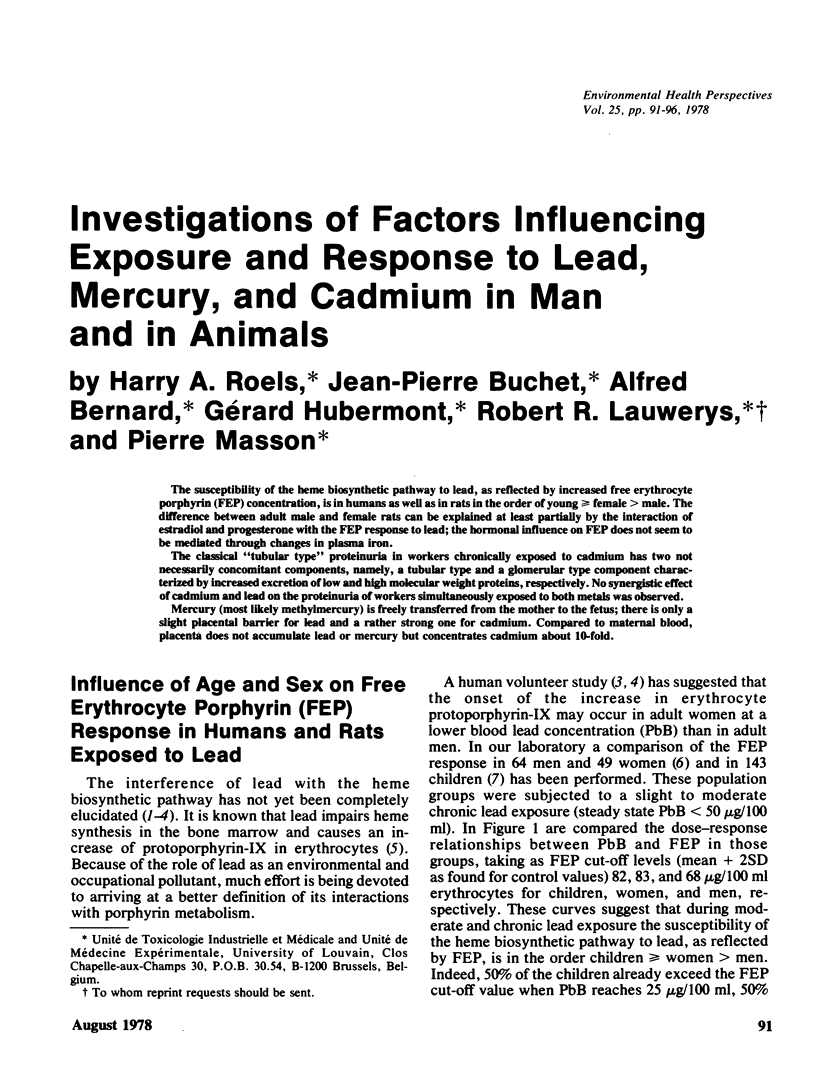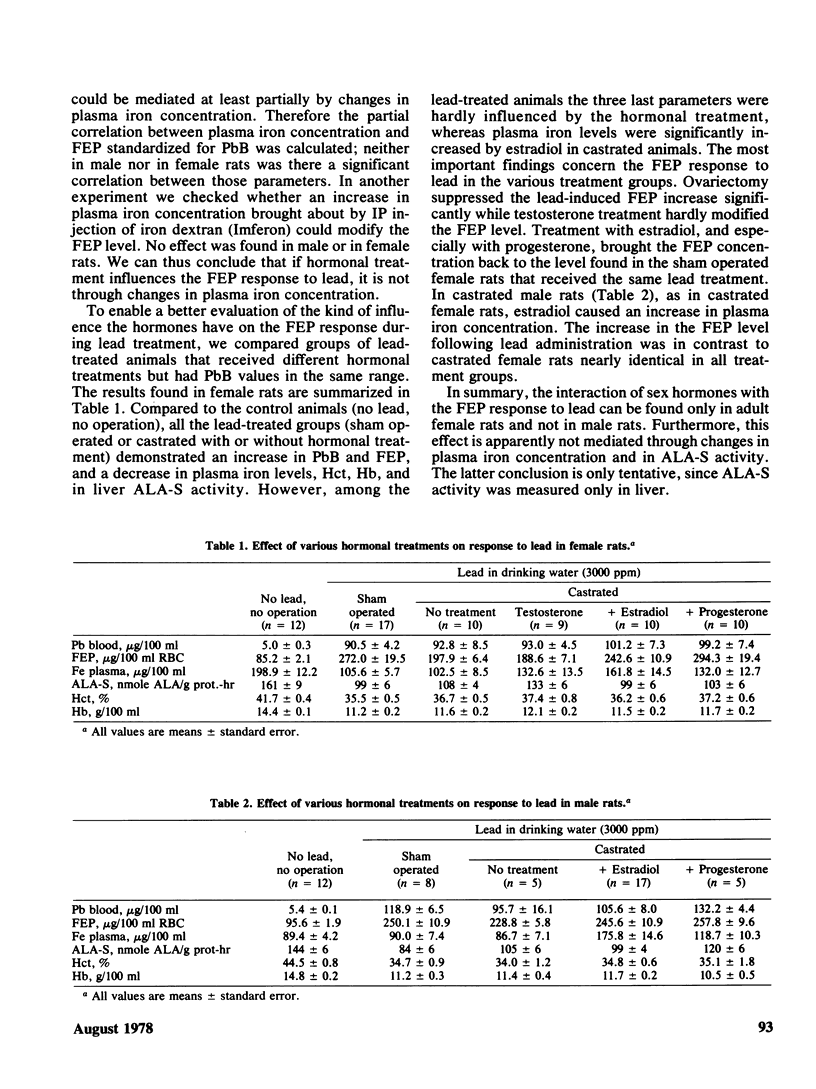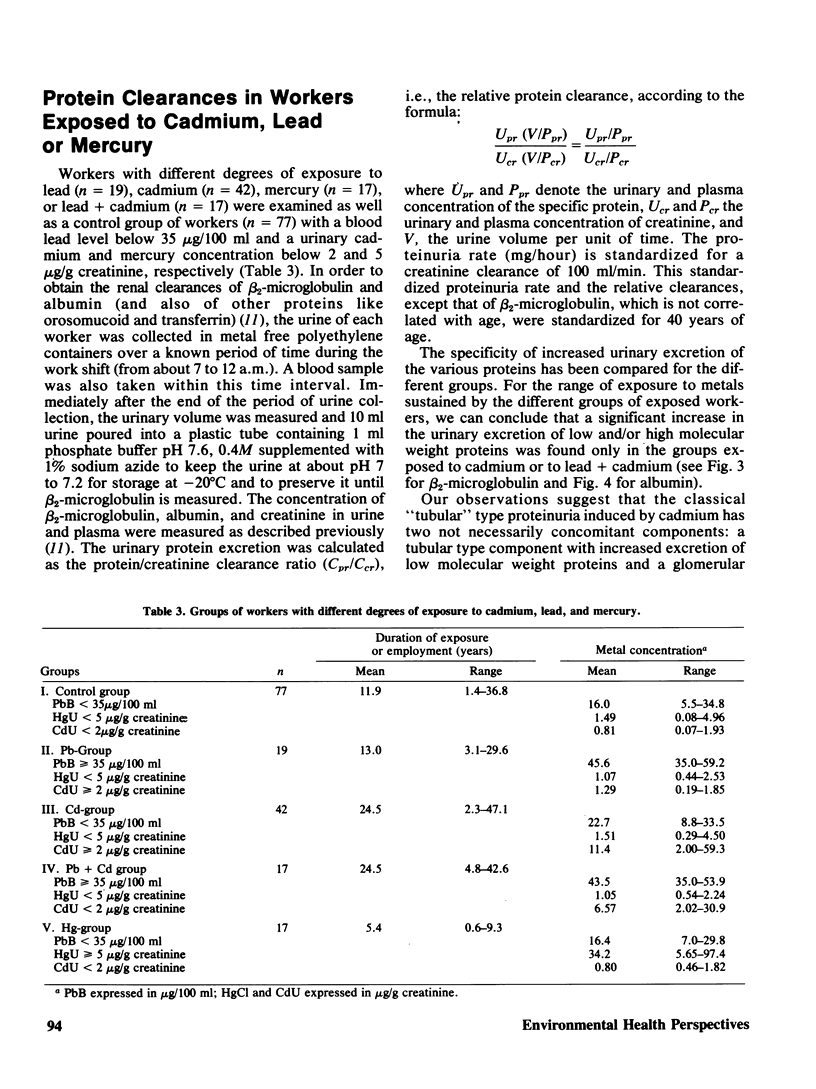Abstract
The susceptibility of the heme biosynthetic pathway to lead, as reflected by increased free erythrocyte porphyrin (FEP) concentration, is in humans as well as in rats in the order of young greater than or equal to female greater than male. The difference between adult male and female rats can be explained at least partially by the interaction of estradiol and progesterone with the FEP response to lead; the hormonal influence on FEP does not seem to be mediated through changes in plasma iron. The classical "tubular type" proteinuria in workers chronically exposed to cadmium has two not necessarily concomitant components, namely, a tubular type and a glomerular type component characterized by increased excretion of low and high molecular weight proteins, respectivley. No synergistic effect of cadmium and lead on the proteinuria of workers simultaneously exposed to both metals was observed. Mercury (most likely methylmercury) is freely transferred from the mother to the fetus; there is only a slight placental barrier for lead and a rather strong one for cadmium. Compared to maternal blood, placenta does not accumulate lead or mercury but concentrates cadmium about 10-fold.
Full text
PDF





Selected References
These references are in PubMed. This may not be the complete list of references from this article.
- Buchet J. P., Roels H., Lauwerys R. Influence of sex hormones on free erythrocyte protoporphyrin response to lead in rats. Toxicology. 1978 Apr;9(4):361–369. doi: 10.1016/0300-483x(78)90019-7. [DOI] [PubMed] [Google Scholar]
- Chisolm J. J., Jr, Hastings C. W., Cheung D. K. Microphotofluorometric assay for protoporphyrin in acidified acetone extracts of whole blood. Biochem Med. 1974 Feb;9(2):113–135. doi: 10.1016/0006-2944(74)90045-3. [DOI] [PubMed] [Google Scholar]
- Granick S., Sassa S., Granick J. L., Levere R. D., Kappas A. Assays for porphyrins, delta-aminolevulinic-acid dehydratase, and porphyrinogen synthetase in microliter samples of whole blood: applications to metabolic defects involving the heme pathway. Proc Natl Acad Sci U S A. 1972 Sep;69(9):2381–2385. doi: 10.1073/pnas.69.9.2381. [DOI] [PMC free article] [PubMed] [Google Scholar]
- Lauwerys R., Buchet J. P., Roels H., Hubermont G. Placental transfer of lead, mercury, cadmium, and carbon monoxide in women. I. Comparison of the frequency distributions of the biological indices in maternal and umbilical cord blood. Environ Res. 1978 Apr;15(2):278–289. doi: 10.1016/0013-9351(78)90104-4. [DOI] [PubMed] [Google Scholar]
- Marver H. S., Tschudy D. P., Perlroth M. G., Collins A. Delta-aminolevulinic acid synthetase. I. Studies in liver homogenates. J Biol Chem. 1966 Jun 25;241(12):2803–2809. [PubMed] [Google Scholar]
- Roels H. A., Buchet J. P., Lauwerys R., Bruaux P., Claeys-Thoreau F., Lafontaine A., van Overschelde J., Verduyn G. Lead and cadmium absorption among children near a nonferrous metal plant: a follow-up study of a test case. Environ Res. 1978 Apr;15(2):290–308. doi: 10.1016/0013-9351(78)90105-6. [DOI] [PubMed] [Google Scholar]
- Roels H. A., Lauwerys R. R., Buchet J. P., Vrelust M. T. Response of free erythrocyte porphyrin and urinary delta-aminolevulinic acid in men and women moderately exposed to lead. Int Arch Arbeitsmed. 1975;34(2):97–108. doi: 10.1007/BF00539128. [DOI] [PubMed] [Google Scholar]
- Roels H., Bruaux P., Buchet J. P., Claeys-Thoreau F., Lauwerys R., Lafontaine A., Hubermont G., Van Overschelde J. Impact of air pollution by lead on the heme biosynthetic pathway in school-age children. Arch Environ Health. 1976 Nov-Dec;31(6):310–316. doi: 10.1080/00039896.1976.10667241. [DOI] [PubMed] [Google Scholar]
- Sassa S., Granick J. L., Granick S., Kappas A., Levere R. D. Studies in lead poisoning. I. Microanalysis of erythrocyte protoporphyrin levels by spectrophotometry in the detection of chronic lead intoxication in the subclinical range. Biochem Med. 1973 Aug;8(1):135–148. doi: 10.1016/0006-2944(73)90017-3. [DOI] [PubMed] [Google Scholar]
- Stuik E. J. Biological response of male and female volunteers to inorganic lead. Int Arch Arbeitsmed. 1974;33(2):83–97. doi: 10.1007/BF00538993. [DOI] [PubMed] [Google Scholar]


